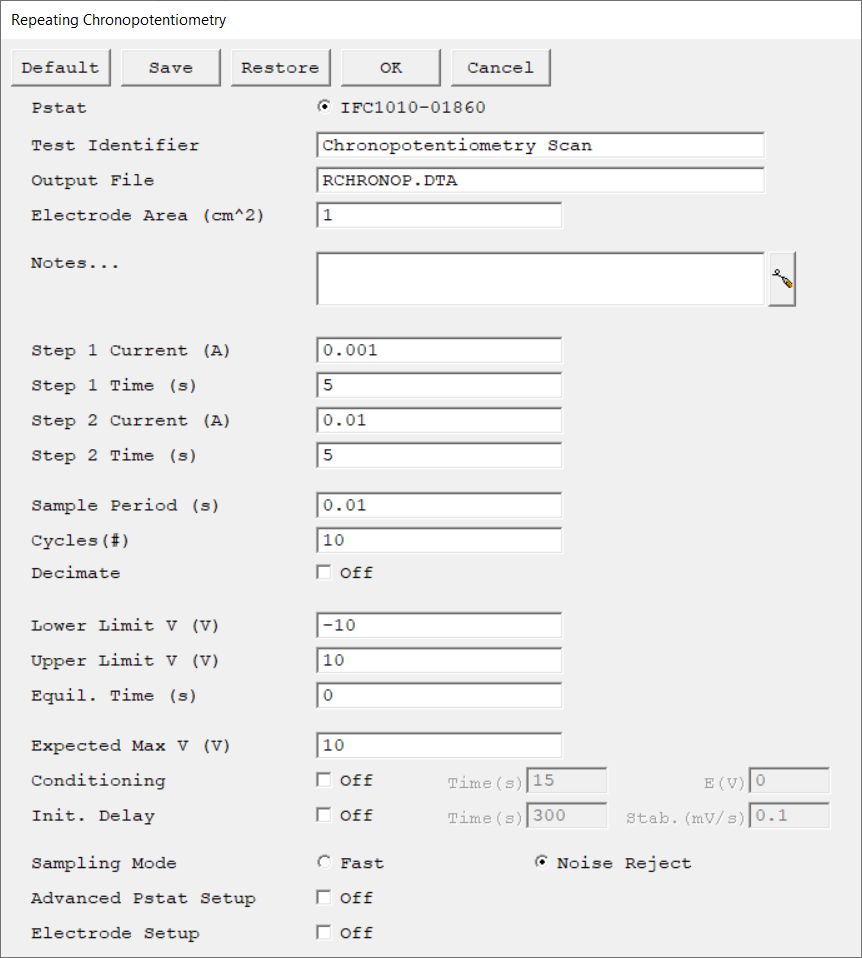Description
Parameter |
Description |
Units |
||
|---|---|---|---|---|
Select the potentiostat/galvanostat to perform the experiment. Each radio button corresponds to an installed potentiostat. You can select only one potentiostat at a time. Potentiostats that are already in use are marked with an asterisk. They can be selected but cannot be used. |
|
|||
A string that is used as a name. It is written to the data file, so it can be used to identify the data in database or data manipulation programs. The Identifier string defaults to a name derived from the technique's name. While this makes an acceptable curve label, it does not generate a unique descriptive label for a data set. The Identifier string is limited to 80 characters. It can include almost any normally printable character. Numbers, upper- and lower-case letters, and the most common punctuation characters including spaces are valid. |
|
|||
The name of the file in which the output data are written. By default, it is saved in the default file directory.
|
|
|||
The surface area of the sample that is exposed to the solution. The software uses the sample area to calculate the current density and corrosion rate (if applicable). If you do not want to enter an area, we recommend that you leave it at the default value of 1.00 cm².
|
cm2 |
|||
Enter several lines of text that describe the experiment. A typical use of Notes is to record the experimental conditions for a data set.
Notes defaults to an empty string and is limited to 400 characters. It can include all printable characters including numbers, upper- and lower-case letters, and the most common punctuation including spaces. Tab characters are not allowed in the Notes string. Press the Notes button on the right-hand side to open a separate Notes dialog box. |
|
|||
The current applied in the first current step. |
amperes (A) |
|||
The duration of the first current step when Step 1 Current is applied. |
seconds (s) |
|||
The current applied in the second current step. |
amperes (A) |
|||
The duration of the second current step when Step 2 Current is applied. |
seconds (s) |
|||
The spacing between data points. The shortest Sample Period we recommend is 0.1 s. The longest Sample Period allowed is 715 s for Reference potentiostats and 750 s for Interface potentiostats.
|
seconds (s) |
|||
The number of times the scan is repeated during the experiment.
Conceptually, it is the number of times the potential cycles from the Step 1 Current to Step 2 Current and back to Step 1 Current. |
|
|||
Enable this option to display the time on a logarithmic scale during the experiment. |
|
|||
Prevents excessive cell voltage. If the value of the potential exceeds Lower Limit V, data acquisition stops and the cell is turned off. |
volts (V) |
|||
Prevents excessive cell voltage. If the value of the potential exceeds the Upper Limit V, data acquisition stops and the cell is turned off. |
volts (V) |
|||
The duration during which the cell remains at the initial potential, with the cell turned on before data acquisition begins. It allows the system to equilibrate before the actual experiment starts. No data are recorded during this step.
|
seconds (s) |
|||
The maximum expected voltage which sets the initial voltage measurement range and voltage offset of the galvanostat. If necessary, the voltage measurement range is adjusted during the signal-optimization phase, but this adds extra time to the experiment. |
volts (V) |
|||
You may condition the electrode as the first step of the experiment, e.g., to remove an oxide film from the electrode or to grow one. Conditioning ensures that the metal sample has a known surface state at the start of the experiment. This step is done potentiostatically for a set amount of time.
|
seconds (s), volts (V) |
|||
The Initial Delay phase of the experiment is the first step to occur in the experimental sequence. This phase of the experiment stabilizes the open-circuit potential of the sample prior to any applied signal and measures that open-circuit potential.
|
seconds (s), mV/s |
|||
Select the sampling method for the experiment. Depending on the experiment type, choose between Fast, Noise Reject, and Surface mode. |
|
|||
The Advanced Pstat Setup checkbox, if checked, opens the Hardware Settings window, to control specific aspects about your hardware. If you are not an advanced user or simply wish to use the default hardware settings as specified in the scripts, just un-check this box. If you wish to specifically set some hardware items, check this box. The Hardware Settings window opens upon clicking the OK button. |
|
|||
The Electrode Setup checkbox, if checked, opens the Electrode Setup window, to control specific aspects about your electrode. If you are not an advanced user, or simply wish to use the default electrode settings, just un-check this box. If you need to specifically set the electrode type, the stir/purge conditions, or some hardware items, check this box. The Electrode Setup window opens upon clicking the OK button. |
|

